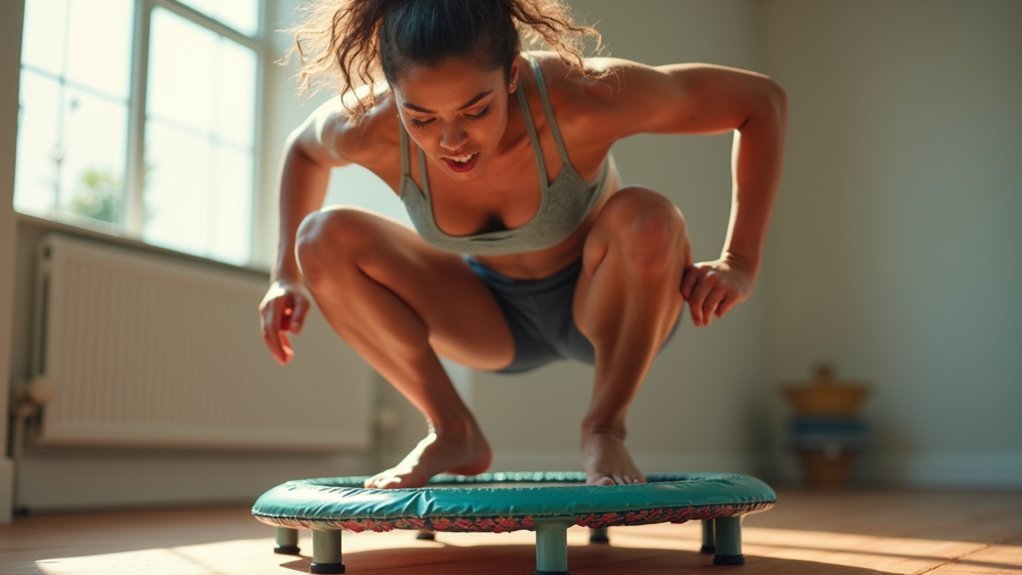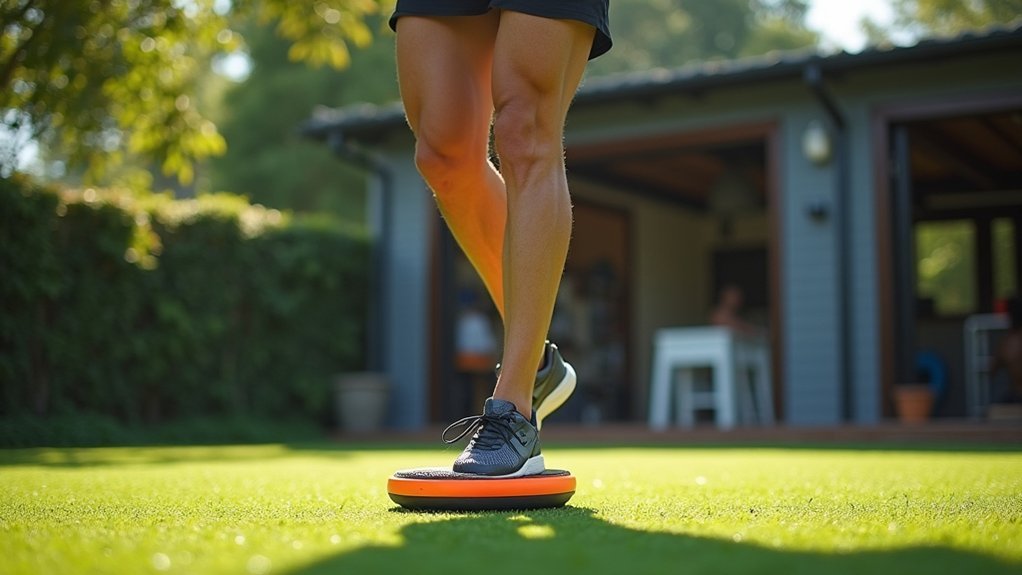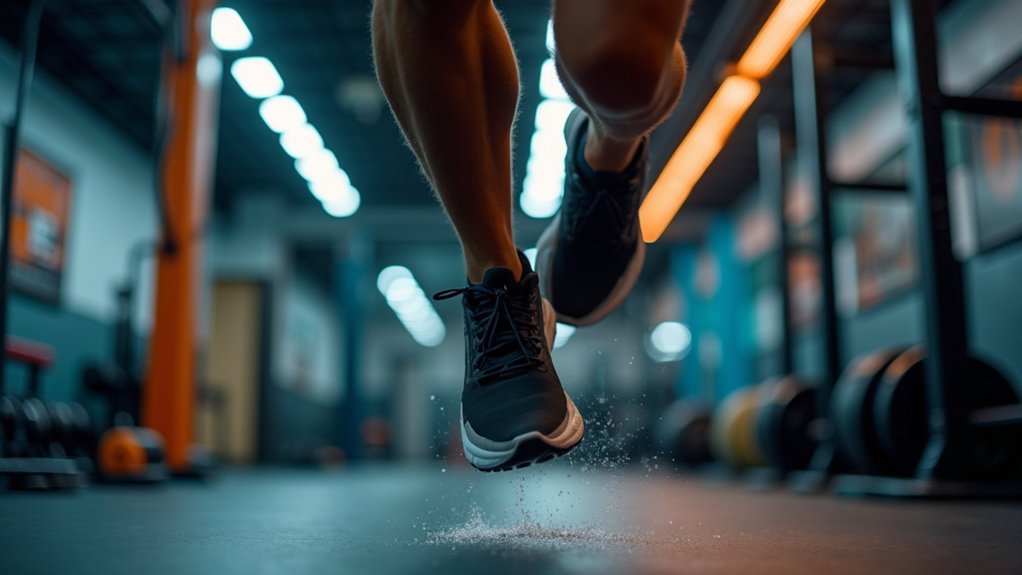Mini-jumper workouts deliver powerful muscle sculpting with minimal impact on your joints. Try these seven key moves: Basic Rebounding Squats for lower body, Twist Jumps for obliques, Tuck Jumps for abs and legs, Heel-to-Butt Kicks for hamstrings, Single-Leg Balance Bounces for stability, Plank-to-Jump Combos for core engagement, and Weighted Arm Pulses for upper body toning. These exercises combine strength, cardio, and balance for extensive muscle definition. Discover how each technique can transform your fitness routine.
Basic Rebounding Squats for Lower-Body Definition

Bounce your way to sculpted legs with rebounding squats, a dynamic exercise that harnesses the power of mini-trampoline elasticity while protecting your joints.
This plyometric movement combines traditional squats with the trampoline’s bounce to build explosive power and strength in your quadriceps and hamstrings.
Stand with feet slightly wider than shoulder-width apart and engage your core. As you descend into the squat, prepare to explode upward, using the rebounder’s surface to amplify your movement.
You’ll immediately feel increased intensity without the harsh impact of floor-based exercises. Rebounding squats effectively strengthen core muscles while simultaneously working your lower body.
For beginners, start with basic movements before increasing depth or adding weights. As you progress, vary your squat depth and jump height to challenge different muscle groups and prevent plateaus.
Your legs will thank you for this low-impact, high-results workout.
Twist Jumps for Core Sculpting and Oblique Strength
Twist jumps represent the perfect fusion of cardio and strength training for your core.
These dynamic movements simultaneously engage your obliques while elevating your heart rate for maximum efficiency.
Engage your core and elevate your cardio simultaneously – twist jumps deliver unmatched efficiency for total body transformation.
Start with feet shoulder-width apart, knees slightly bent. Explosively jump upward while rotating your torso to one side, then immediately spring back up and twist to the opposite direction upon landing.
Keep your core tight and chest lifted throughout.
You’ll notice improved balance, posture, and energy levels as your oblique strength develops.
For added challenge, try performing twist jumps on a mini-trampoline or gradually increasing your jump height and speed.
Always warm up before attempting twist jumps, and focus on soft landings to protect your joints.
For outdoor sessions, choose grass or foam surfaces to reduce impact.
Using arms bent at 90 degrees will help you generate more power and achieve better rotational strength during each twist jump.
Tuck Jumps to Target Abdominal and Leg Muscles

Tuck jumps take your mini-jumper routine to new heights by specifically targeting your abdominal muscles while simultaneously strengthening your leg muscles.
This powerful plyometric move engages your core, quads, hamstrings, and glutes in one explosive motion.
Start with feet shoulder-width apart and core engaged. Bend into a quarter squat, then explosively jump upward, tucking your knees toward your chest mid-air. Use your arms to generate momentum, then land softly to protect your joints.
You’ll not only build functional strength across multiple muscle groups but also boost your cardiovascular endurance and proprioception. For optimal results, perform tuck jumps when you’re fresh, as they require significant central nervous system energy.
The rapid cycle from jump to controlled landing enhances your power production while improving your body’s ability to absorb force—making you more athletic in everyday movements.
Heel-to-Butt Kicks for Hamstring and Gluteal Toning
Heel-to-butt kicks transform simple jumping movements into a targeted posterior chain workout that efficiently sculpts and strengthens your hamstrings and glutes. This equipment-free exercise activates multiple muscle groups while improving your running mechanics.
Maintain an upright posture with a slight forward lean as you perform the movement. Focus on bringing your heels directly to your glutes with each step, landing softly on your midfoot to minimize joint impact. Coordinate your arm motion with each kick, bending elbows at 90 degrees. This fundamental running drill helps increase stride efficiency and optimizes your running form.
You’ll reap dual benefits: enhanced flexibility in your quadriceps and hip flexors while building power in your hamstrings and calves.
Incorporate heel-to-butt kicks in your warm-up routine for 30-60 seconds or add them to HIIT workouts for fat-burning intensity.
Single-Leg Balance Bounces for Muscle Stabilization

Stand on one leg and perform small, controlled bounces to fire up your core stabilizers while simultaneously strengthening those often-neglected ankle muscles.
You’ll notice immediate engagement through your entire kinetic chain as your body works to maintain balance during this challenging unilateral exercise.
Progress by moving from firm surfaces to unstable platforms, or try closing your eyes to amplify the proprioceptive demands on your neuromuscular system. This exercise not only enhances athletic performance but also contributes to longevity and mortality reduction when practiced regularly.
Isolate Core Stabilizers
When your core engages properly, your entire body becomes more stable and efficient. Single-leg balance bounces target these essential stabilizing muscles, reducing inefficient muscle co-contractions while enhancing your proprioception and neuromuscular control.
You’ll notice improved posture as your core strengthens, creating a foundation for all movement patterns. The exercise activates synergies between your ankle, knee, and hip muscles—particularly your tibialis anterior, quadriceps, hamstrings, and gluteus medius. Single-leg movements effectively mimic natural gait and athletic movements we use in everyday life.
Regular practice sharpens your reflexes and coordination, benefiting everything from daily activities to athletic performance. You’re also building protection against injuries and falls as your supporting muscles strengthen.
Start in a safe environment to maximize benefits without risk, gradually challenging your balance to develop long-term stability that contributes to overall health and longevity.
Enhance Ankle Strength
Single-leg balance bounces target your ankle complex directly, transforming weak spots into powerful stabilizers. By challenging proprioceptive feedback mechanisms, these exercises refine your positional awareness while correcting leg-to-leg imbalances. Running efficiency improves significantly as these exercises help you develop the stability needed for each stride’s single leg stance phase.
Start with 60-second holds, then progress to dynamic movements by adding controlled lateral jumps. The eccentric lowering phase strengthens your Achilles and calf muscles, building resilience against sprains and reducing injury risk. For maximum benefit, incorporate trunk rotations to mimic real-world directional changes.
Perform 2-3 sets of 10 reps three times weekly, gradually advancing to unstable surfaces for greater difficulty. You’ll notice improved running economy as push-off power increases, while your vertical jump and agility will benefit from enhanced unilateral strength.
Pair with post-workout calf rolling for peak recovery.
Progressive Balance Challenges
Progressive difficulty challenges transform simple balance exercises into powerful muscle stabilizers. Your body’s neuromuscular system adapts rapidly when you introduce single-leg bouncing on unstable surfaces like a Togu Jumper. Studies have demonstrated that effective balance gains can be achieved with minimal training sessions, making this approach both time-efficient and results-driven. For maximum results, follow an 8-week program with two 45-minute sessions weekly.
| Challenge Level | Exercise | Muscle Benefit |
|---|---|---|
| Beginner | Static single-leg hold | Activates gluteus medius |
| Intermediate | Small controlled bounces | Enhances proprioception |
| Advanced | Directional shifts | Builds cross-limb stability |
| Expert | Eyes-closed bounces | Forces deeper stabilization |
| Elite | Add object catching | Creates functional strength |
Combine these balance challenges with targeted hip strengthening for complete stabilization. Even a single 10-minute session creates immediate improvements, while consistent practice develops lasting postural control that transfers to athletic performance and injury prevention.
Plank-to-Jump Combos for Full-Body Muscle Engagement
You’ll transform your core and abs with plank-to-jump combos that maintain isometric contraction while your lower body explodes into dynamic movement.
This balance-strength fusion method engages multiple muscle groups simultaneously—from your shoulder stabilizers and erector spinae to your rectus abdominis and obliques.
Try adding progressive overload through tempo manipulation or wider leg splits to continually challenge your body’s proprioceptive systems and enhance functional strength. Incorporating variations like plank jacks can effectively combine cardio and core strength training in one efficient movement.
Core-Abs Transformation Technique
While traditional ab exercises often isolate core muscles, our Plank-to-Jump Combo technique revolutionizes your approach by engaging multiple muscle groups simultaneously. Your transverse abdominis and rectus abdominis activate throughout the exercise, creating dynamic stabilization during planks and power during jumps.
You’ll engage your shoulders, chest, and triceps in the plank position while challenging your glutes and quads during explosive jumps. This full-body recruitment considerably increases metabolic demand compared to isolated core work. The technique may also help reduce back pain through improved spinal alignment during proper execution.
For maximum results, maintain continuous core tension to prevent spinal sagging. Try performing on unstable surfaces to increase muscle activation, or slow the eccentric phase for greater time under tension.
Begin with the step-back version if you’re new, then progress to explosive jumps as your strength improves.
Balance-Strength Fusion Method
The Balance-Strength Fusion Method takes core conditioning to new heights by combining dynamic plank stability with explosive jumping movements. This technique engages multiple muscle groups simultaneously, creating a powerful full-body workout.
Start with plank jacks for foundational strength, then progress to plank jumps as your stability improves. For maximum muscle activation, incorporate pike to plank jumps, which target your core, shoulders, and glutes while boosting cardiovascular fitness.
Always maintain proper form—keep your body in a straight line and engage your core throughout each movement. For plank jumps, ensure that your hands remain under your shoulders to maintain proper alignment and maximize effectiveness.
Add variety with plank up-downs or shoulder taps to challenge different muscle groups. You’ll notice improvements in both balance and strength as these exercises develop your stabilizing muscles.
The best part? You’ll sculpt your entire body with no equipment needed, making this method perfect for any location.
Weighted Arm Pulses During Gentle Rebounding
Integrating weighted arm pulses into your gentle rebounding routine creates a powerful combination for total-body sculpting. While you’re gently bouncing, add lightweight dumbbells to engage your upper body and core simultaneously. This dual-action approach increases your heart rate, boosts calorie burn, and improves coordination as your body synchronizes arm and leg movements. Adding this exercise to your fitness regimen helps enhance balance and motor skills over time.
Adding arm weights to gentle rebounding transforms a simple bounce into a full-body sculpting session that burns calories while improving coordination.
- Your lymphatic system gets a double benefit—the gentle bouncing stimulates fluid circulation while the arm movements enhance upper body drainage.
- Start with lighter weights (1-2 pounds) and perfect your form before progressing to heavier options.
- Keep your core engaged and posture tall throughout each pulse to maximize muscle recruitment and protect your spine.
Frequently Asked Questions
How Much Weight Can a Standard Mini-Jumper Safely Support?
Standard mini-jumpers don’t typically specify exact weight limits. You’ll find the Jungle Jumparoo Mini, designed for ages 2-7, has a heavy base for stability. Always check manufacturer guidelines for your specific model’s capacity.
Can Mini-Jumper Exercises Help Reduce Cellulite Appearance?
Yes, mini-jumper exercises can help reduce cellulite appearance. You’ll activate your lymphatic system, tone muscles, improve circulation, and boost metabolism—all factors that work together to diminish the orange-peel texture over time.
How Long Should Beginners Rebound Before Seeing Muscle Definition Results?
You’ll typically notice improved muscle definition after 6-8 weeks of consistent rebounding. Aim for 3-4 sessions weekly, progressing from 15-20 minutes to 30-45 minutes, while incorporating strength-focused moves like scissors and surf twists.
Are Mini-Jumpers Suitable for People With Knee Replacements?
No, mini-jumpers aren’t generally suitable after knee replacement. You’ll risk damaging your new joint with repetitive impacts. Instead, try low-impact alternatives like swimming, cycling, or resistance bands for muscle sculpting and cardiovascular benefits.
What Shoes Are Best for Mini-Jumper Workouts?
For mini-jumper workouts, you’ll want minimalist or wrestling shoes with flat soles and minimal cushioning. They provide stability and balance while preventing ankle strain. Avoid running shoes with thick, cushioned soles that cause instability.
In Summary
You’ll transform your physique in just minutes a day with these mini-jumper exercises. They’re low-impact but deliver high-intensity results, sculpting muscles while improving your balance and coordination. Whether you’re a fitness beginner or experienced athlete, you can modify these movements to match your level. Add rebounding to your routine 3-4 times weekly, and you’ll soon notice firmer muscles and increased definition throughout your body.





Leave a Reply